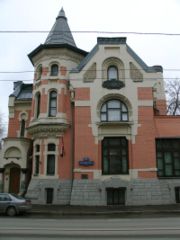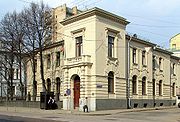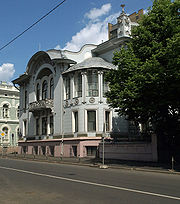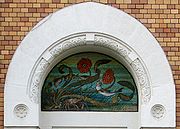
Lev Kekushev
Encyclopedia
Lev Nikolayevich Kekushev was a Russia
n architect, notable for his Art Nouveau
buildings in Moscow
, built in the 1890s and early 1900s in the original, Franco-Belgian variety of this style. Kekushev's buildings are notable for his skillful use of metal ornaments and his signature with a lion (Lev) ornament or sculpture.
(Maria Naschokina, p. 253; Simbirsk according to other sources). Kekushev graduated high school in Vilnius, and the Institute of Civil Engineers in Saint Petersburg
(1883–1889). For one year, he worked as a state-employed construction engineer in Saint Petersburg, but relocated to Moscow in 1890. At first an assistant to architect Semyon Eybushits, he started independent practice in 1893. At the same time, Kekushev became a master in applied art technologies - iron forging
, silver galvanization
and chemical frosting of glass
. Throughout the 1890s, Kekushev and Illarion Ivanov-Shitz were employed by Moscow-based railway companies and designed dozens of extant railway stations.
 Kekushev was the first practitioner of Art Nouveau
Kekushev was the first practitioner of Art Nouveau
in Moscow, starting with his apartment buildings in Varsonofyevskay Lane and Bolshaya Dmitrovks, completed 1893. His style (unlike the next generation of Art Nouveau architects like William Walcot
and Fyodor Schechtel
) is very close to the original Belgian style of Victor Horta
. The new wave of architecture was endorsed and financed by prominent business figures like the Khludov and Morozov families and Jacob Reck.
In 1898-1899, Kekushev won the first prize in the open contest for Hotel Metropol
; financier Savva Morozov discarded the decision of a professional jury and awarded architectural design to William Walcot
. However, the owners retained Kekushev as overall project manager. "None of this (Walcot's earlier) work is on the scale of the Metropole; Kekushev's assistance was probably crucial to the final realization of this complex structure, with its immense dome of glass and iron over an interior court" (Brumfield, chapter 3).
 Kekushev's talent and recognition peaked in 1900-1903, when Art Nouveau, for a while, became the dominant style in Moscow. His buildings include such diverse luxury residences as the timber-framed
Kekushev's talent and recognition peaked in 1900-1903, when Art Nouveau, for a while, became the dominant style in Moscow. His buildings include such diverse luxury residences as the timber-framed
Nosov House (Electrozavodskaya Street) and stone and steel Mindovsky House (44 Povarskaya Street, now Embassy of New Zealand
- a part of a large affluent community developed by Jacob Reck). Kekushev, skilled in interior finishes, practiced Gesamtkunstwerk
approach, designing interiors down to the smallest details. Unlike other architects, who commissioned artwork finishes to independent artists, all Kekushev buildings have distinct Kekushev metal ornaments.
 After the Russian revolution of 1905
After the Russian revolution of 1905
, when public opinion "dismissed Art Nouveau as ephemera
of fashion" (Brumfield, chapter 3) in favor of Neoclassical revival
, Kekushev was unwilling or unable to change, and worked on low-profile, unimportant projects. By 1912 he practically disappeared from professional scene.
Maria Naschokina, a historian of Art Nouveau, suggested that Kekushev's withdrawal was actually caused by unspecified (probably, mental) illness; this statement has not been thoroughly proved. Kekushev's last years remain a mystery; even the year of his death is disputed (1916 to 1919).
who saw combat in 1924 in Central Asia, later working as aircraft engineer on Arctic flights in the 1920s and 1930s. He was a member of Pavel Golovin
's air crew that was the first to reach the North Pole
on May 5, 1937 in preparation for Ivan Papanin
's polar expedition. During World War II
, he flew 59 missions on a DC-3
to and from besieged Leningrad
, evacuating starving residents; later, he served on anti-submarine
Arctic patrols. In 1948 Nikolay Kekushev was arrested, and he spent six years in Dzhezkazgan
labor camps. He survived and wrote a book of memoirs, Zveriada; however, it does not reveal much about his father's last years.

Russia
Russia or , officially known as both Russia and the Russian Federation , is a country in northern Eurasia. It is a federal semi-presidential republic, comprising 83 federal subjects...
n architect, notable for his Art Nouveau
Art Nouveau
Art Nouveau is an international philosophy and style of art, architecture and applied art—especially the decorative arts—that were most popular during 1890–1910. The name "Art Nouveau" is French for "new art"...
buildings in Moscow
Moscow
Moscow is the capital, the most populous city, and the most populous federal subject of Russia. The city is a major political, economic, cultural, scientific, religious, financial, educational, and transportation centre of Russia and the continent...
, built in the 1890s and early 1900s in the original, Franco-Belgian variety of this style. Kekushev's buildings are notable for his skillful use of metal ornaments and his signature with a lion (Lev) ornament or sculpture.
Education
Kekushev was born in the family of a Russian officer in VilniusVilnius
Vilnius is the capital of Lithuania, and its largest city, with a population of 560,190 as of 2010. It is the seat of the Vilnius city municipality and of the Vilnius district municipality. It is also the capital of Vilnius County...
(Maria Naschokina, p. 253; Simbirsk according to other sources). Kekushev graduated high school in Vilnius, and the Institute of Civil Engineers in Saint Petersburg
Saint Petersburg
Saint Petersburg is a city and a federal subject of Russia located on the Neva River at the head of the Gulf of Finland on the Baltic Sea...
(1883–1889). For one year, he worked as a state-employed construction engineer in Saint Petersburg, but relocated to Moscow in 1890. At first an assistant to architect Semyon Eybushits, he started independent practice in 1893. At the same time, Kekushev became a master in applied art technologies - iron forging
Forging
Forging is a manufacturing process involving the shaping of metal using localized compressive forces. Forging is often classified according to the temperature at which it is performed: '"cold," "warm," or "hot" forging. Forged parts can range in weight from less than a kilogram to 580 metric tons...
, silver galvanization
Galvanization
Galvanization is the process of applying a protective zinc coating to steel or iron, in order to prevent rusting. The term is derived from the name of Italian scientist Luigi Galvani....
and chemical frosting of glass
Frosted glass
Frosted glass is produced by the sandblasting or acid etching of clear sheet glass. It has the effect of rendering the glass translucent by scattering of light during transmission, thus blurring images while still transmitting light.Applications:...
. Throughout the 1890s, Kekushev and Illarion Ivanov-Shitz were employed by Moscow-based railway companies and designed dozens of extant railway stations.
Art Nouveau

Art Nouveau
Art Nouveau is an international philosophy and style of art, architecture and applied art—especially the decorative arts—that were most popular during 1890–1910. The name "Art Nouveau" is French for "new art"...
in Moscow, starting with his apartment buildings in Varsonofyevskay Lane and Bolshaya Dmitrovks, completed 1893. His style (unlike the next generation of Art Nouveau architects like William Walcot
William Walcot
William Walcot was a British architect graphic artist and etcher, notable as a practitioner of refined Art Nouveau in Moscow, Russia . His trademark Lady's Head keystone ornament became the easily recognizable symbol of Russian Style Moderne...
and Fyodor Schechtel
Fyodor Schechtel
Fyodor Osipovich Schechtel was a Russian architect, graphic artist and stage designer, the most influential and prolific master of Russian Art Nouveau and late Russian Revival....
) is very close to the original Belgian style of Victor Horta
Victor Horta
Victor, Baron Horta was a Belgian architect and designer. John Julius Norwich described him as "undoubtedly the key European Art Nouveau architect." Indeed, Horta is one of the most important names in Art Nouveau architecture; the construction of his Hôtel Tassel in Brussels in 1892-3 means that...
. The new wave of architecture was endorsed and financed by prominent business figures like the Khludov and Morozov families and Jacob Reck.
In 1898-1899, Kekushev won the first prize in the open contest for Hotel Metropol
Hotel Metropol (Moscow)
Hotel Metropol is a historical hotel in the center of Moscow, Russia, built in 1899-1907 in Art Nouveau style. It is notable as the largest extant Moscow hotel built before the Russian Revolution of 1917, and for the unique collaboration of architects and artists .In 1898, Savva Mamontov...
; financier Savva Morozov discarded the decision of a professional jury and awarded architectural design to William Walcot
William Walcot
William Walcot was a British architect graphic artist and etcher, notable as a practitioner of refined Art Nouveau in Moscow, Russia . His trademark Lady's Head keystone ornament became the easily recognizable symbol of Russian Style Moderne...
. However, the owners retained Kekushev as overall project manager. "None of this (Walcot's earlier) work is on the scale of the Metropole; Kekushev's assistance was probably crucial to the final realization of this complex structure, with its immense dome of glass and iron over an interior court" (Brumfield, chapter 3).

Timber framing
Timber framing , or half-timbering, also called in North America "post-and-beam" construction, is the method of creating structures using heavy squared off and carefully fitted and joined timbers with joints secured by large wooden pegs . It is commonplace in large barns...
Nosov House (Electrozavodskaya Street) and stone and steel Mindovsky House (44 Povarskaya Street, now Embassy of New Zealand
New Zealand
New Zealand is an island country in the south-western Pacific Ocean comprising two main landmasses and numerous smaller islands. The country is situated some east of Australia across the Tasman Sea, and roughly south of the Pacific island nations of New Caledonia, Fiji, and Tonga...
- a part of a large affluent community developed by Jacob Reck). Kekushev, skilled in interior finishes, practiced Gesamtkunstwerk
Gesamtkunstwerk
A Gesamtkunstwerk is a work of art that makes use of all or many art forms or strives to do so...
approach, designing interiors down to the smallest details. Unlike other architects, who commissioned artwork finishes to independent artists, all Kekushev buildings have distinct Kekushev metal ornaments.
Withdrawal from practice

Russian Revolution of 1905
The 1905 Russian Revolution was a wave of mass political and social unrest that spread through vast areas of the Russian Empire. Some of it was directed against the government, while some was undirected. It included worker strikes, peasant unrest, and military mutinies...
, when public opinion "dismissed Art Nouveau as ephemera
Ephemera
Ephemera are transitory written and printed matter not intended to be retained or preserved. The word derives from the Greek, meaning things lasting no more than a day. Some collectible ephemera are advertising trade cards, airsickness bags, bookmarks, catalogues, greeting cards, letters,...
of fashion" (Brumfield, chapter 3) in favor of Neoclassical revival
Russian neoclassical revival
Russian neoclassical revival was a trend in Russian culture, mostly pronounced in architecture, that briefly replaced eclecticism and Art Nouveau as the leading architectural style between the Revolution of 1905 and the outbreak of World War I, coexisting with the Silver Age of Russian Poetry...
, Kekushev was unwilling or unable to change, and worked on low-profile, unimportant projects. By 1912 he practically disappeared from professional scene.
Maria Naschokina, a historian of Art Nouveau, suggested that Kekushev's withdrawal was actually caused by unspecified (probably, mental) illness; this statement has not been thoroughly proved. Kekushev's last years remain a mystery; even the year of his death is disputed (1916 to 1919).
Nikolay Kekushev
The architect's son, Nikolay Kekushev, was a famous aviatorAviator
An aviator is a person who flies an aircraft. The first recorded use of the term was in 1887, as a variation of 'aviation', from the Latin avis , coined in 1863 by G. de la Landelle in Aviation Ou Navigation Aérienne...
who saw combat in 1924 in Central Asia, later working as aircraft engineer on Arctic flights in the 1920s and 1930s. He was a member of Pavel Golovin
Pavel Golovin
Pavel Golovin was a Soviet polar aviation pilot, colonel.Golovin was the first Soviet pilot to fly over the North Pole, on May 5 1937....
's air crew that was the first to reach the North Pole
North Pole
The North Pole, also known as the Geographic North Pole or Terrestrial North Pole, is, subject to the caveats explained below, defined as the point in the northern hemisphere where the Earth's axis of rotation meets its surface...
on May 5, 1937 in preparation for Ivan Papanin
Ivan Papanin
Ivan Dmitrievich Papanin was a Russian Polar Explorer, Scientist,Counter Admiral, twice Hero of the Soviet Union awarded nine Orders of Lenin...
's polar expedition. During World War II
World War II
World War II, or the Second World War , was a global conflict lasting from 1939 to 1945, involving most of the world's nations—including all of the great powers—eventually forming two opposing military alliances: the Allies and the Axis...
, he flew 59 missions on a DC-3
Douglas DC-3
The Douglas DC-3 is an American fixed-wing propeller-driven aircraft whose speed and range revolutionized air transport in the 1930s and 1940s. Its lasting impact on the airline industry and World War II makes it one of the most significant transport aircraft ever made...
to and from besieged Leningrad
Saint Petersburg
Saint Petersburg is a city and a federal subject of Russia located on the Neva River at the head of the Gulf of Finland on the Baltic Sea...
, evacuating starving residents; later, he served on anti-submarine
Submarine
A submarine is a watercraft capable of independent operation below the surface of the water. It differs from a submersible, which has more limited underwater capability...
Arctic patrols. In 1948 Nikolay Kekushev was arrested, and he spent six years in Dzhezkazgan
Dzhezkazgan
Jezkazgan or Zhezkazgan , formerly known as Dzhezkazgan , is a city in Karagandy Province, Kazakhstan, on a reservoir of the Kara-Kengir River. The city population is of 90,000...
labor camps. He survived and wrote a book of memoirs, Zveriada; however, it does not reveal much about his father's last years.
Selected buildings

Assistant to Semyon Eybuschits
- 1890-1893 - Central Public Baths
- 1890-1893 - Okhotny Ryad redevelopment
Assistant to Sergey Tikhomirov
- 1890-1893 - Apartment Building of Gregory the Theosof Church, Bolshaya Dmitrovka Street
Own practice
- 1892 - 1899 I.N.Geyer AlmshouseAlmshouseAlmshouses are charitable housing provided to enable people to live in a particular community...
, 15 Verkhaya Krasnoselskaya, photographs - 1893 - Gagarin Apartment Building, Varsonofievsky Lane (partly destroyed by facadistFacadismFaçadism is the practice of demolishing a building but leaving its facade intact for the purposes of building new structures in it or around it....
"reconstruction" in 2000s) - 1894 - 1895 - Korobkov House, Pyatnitskaya Street (with Sergey Shutzman)
- 1894 - 1896 - Khludov Apartment Building,
- 1898 - 1900 - Grachev Estate, KhovrinoKhovrinoKhovrino may refer to:*Khovrino District, a district of Northern Administrative Okrug, Moscow, Russia*Khovrino , name of several rural localities in Russia...
, now 77 Festivalnaya Street, Moscow, modelled after casino in Monte-Carlo by Charles GarnierCharles Garnier (architect)Charles Garnier was a French architect, perhaps best known as the architect of the Palais Garnier and the Opéra de Monte-Carlo.-Early life:... - 1898 - 1899 - Gustav List House, 8 Glazovsky Lane, with William WalcotWilliam WalcotWilliam Walcot was a British architect graphic artist and etcher, notable as a practitioner of refined Art Nouveau in Moscow, Russia . His trademark Lady's Head keystone ornament became the easily recognizable symbol of Russian Style Moderne...
mosaic friezeFriezethumb|267px|Frieze of the [[Tower of the Winds]], AthensIn architecture the frieze is the wide central section part of an entablature and may be plain in the Ionic or Doric order, or decorated with bas-reliefs. Even when neither columns nor pilasters are expressed, on an astylar wall it lies upon...
. Kekushev started this building for himself, but halfway into construction, List offered him the bounty Kekushev could not resist. - 1898 - 1899 -OdintsovoOdintsovoOdintsovo is a city in Moscow Oblast, Russia. Population: Town status was granted to it in 1957.-History:The village of Odintsovo was formed in the late 14th century. The famous story among the Odintsovians is about the noble named Andrey Odinets.Odintsovo is a city in Moscow Oblast, Russia....
rail station - 1899 - Nekrasov Building, 4 Gogol BoulevardGogol BoulevardGogolevsky Boulevard is a boulevard in Kitay-gorod, Moscow, Russia, named after the writer Nikolai Gogol.The boulevard begins next to the Cathedral of Christ the Saviour, and is the beginning of the Boulevard Ring. The boulevard runs north-east and ends at the Arbat Square, from where it continues...
- 1899 - 1900 - Saarbekov House, Povarskaya Street
- 1899 - 1900 - Iberian Trade Rows, Nikolskaya Street
- 1900 - 1903 - Own house, 21 Ostozhenka Street (also known as Kekysheva House, as he had to give it to his ex-wife in settling their divorce)
- 1902 - 21, Gogol BoulevardGogol BoulevardGogolevsky Boulevard is a boulevard in Kitay-gorod, Moscow, Russia, named after the writer Nikolai Gogol.The boulevard begins next to the Cathedral of Christ the Saviour, and is the beginning of the Boulevard Ring. The boulevard runs north-east and ends at the Arbat Square, from where it continues...
- 1903 - Nosov House, Electrozavodskaya Street
- 1903 - Mindovsky House, 44 Povarskaya Street (Embassy of New ZealandEmbassy of New Zealand in MoscowThe Embassy of New Zealand in Moscow is the diplomatic mission of New Zealand in the Russian Federation. It is located at 44 Povarskaya Street in the Arbat district of Moscow....
) interior photographs - 1903-1904 - Ponizovsky House, 42 Povarskaya Street (Embassy of AfghanistanEmbassy of Afghanistan in MoscowThe Embassy of Afghanistan in Moscow is the diplomatic mission of the Islamic Republic of Afghanistan to the Russian Federation...
) - 1898 - 1907 - construction manager for Hotel Metropol (Moscow)Hotel Metropol (Moscow)Hotel Metropol is a historical hotel in the center of Moscow, Russia, built in 1899-1907 in Art Nouveau style. It is notable as the largest extant Moscow hotel built before the Russian Revolution of 1917, and for the unique collaboration of architects and artists .In 1898, Savva Mamontov...
, lead architect: William WalcotWilliam WalcotWilliam Walcot was a British architect graphic artist and etcher, notable as a practitioner of refined Art Nouveau in Moscow, Russia . His trademark Lady's Head keystone ornament became the easily recognizable symbol of Russian Style Moderne... - 1904 - 1906 - Isakov Apartment Building, 28 Prechistenka Street
- 1906 - Railway stations of MoscowMoscowMoscow is the capital, the most populous city, and the most populous federal subject of Russia. The city is a major political, economic, cultural, scientific, religious, financial, educational, and transportation centre of Russia and the continent...
-YaroslavlYaroslavlYaroslavl is a city and the administrative center of Yaroslavl Oblast, Russia, located northeast of Moscow. The historical part of the city, a World Heritage Site, is located at the confluence of the Volga and the Kotorosl Rivers. It is one of the Golden Ring cities, a group of historic cities...
railroad - 1906 - Interiors, Praga Restaurant (Arbat SquareArbat SquareArbatskaya Square of Arbat Square is one of the oldest squares of Moscow, located on the junction of Gogolevsky Boulevard, Znamenka Street and Arbat Gates Square ....
) and Morozov House (Prechistenka Street) - 1910 - expansion of Yaroslavsky Rail TerminalYaroslavsky Rail TerminalYaroslavsky Rail Terminal is one of the nine railway terminals in Moscow, situated on the Komsomolskaya Square. It has the highest passenger throughput of all the nine Moscow rail terminals, serving eastern destinations, including the Russian Far East. It is the terminus of the Trans-Siberian...
- 1911 - Rudnev Hospital, Serebryany Lane
- 1912 - Hospital near Preobrazhenskoye CemeteryPreobrazhenskoye CemeteryPreobrazhenka Cemetery is a cemetery in the northern part of Moscow long associated with Old Believers. It was inaugurated by a Fedoseevtsy merchant in 1777 as a plague quarantine disguising the Bespopovtsy monastery. At that time the territory of the cemetery was located outside Moscow, but near...

